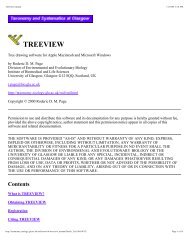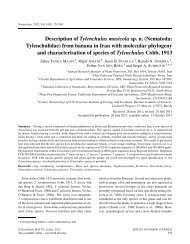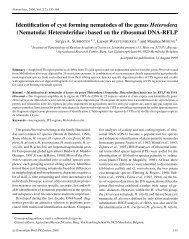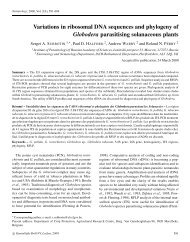Madina Rasulova Molecular Systematics of Nematodes Page 1
Madina Rasulova Molecular Systematics of Nematodes Page 1
Madina Rasulova Molecular Systematics of Nematodes Page 1
You also want an ePaper? Increase the reach of your titles
YUMPU automatically turns print PDFs into web optimized ePapers that Google loves.
phylogenetic trees based on the posterior probability distribution <strong>of</strong> trees which resulted in files including<br />
“PROJECT_BItree.mcmc”, “PROJECT_BItree.con” and several others. Finally, all obtained phylogenetic<br />
trees were visualized by the help <strong>of</strong> the program TreeView.<br />
RESULTS<br />
The study <strong>of</strong> the given nucleotide sequence <strong>of</strong> Belonolaimus genus by BLAST in NCBI GeneBank<br />
revealed partial sequence <strong>of</strong> 18S ribosomal RNA <strong>of</strong> Belonolaimus longicaudatus GV-2 (accession number<br />
DQ494797) with complete internal transcribed spacer 1 (ITS1) region and partial 5.8S ribosomal RNA<br />
gene the authors <strong>of</strong> which were Han, Jeyaprakash, Weingarther and Dickson (2006).<br />
4 isolates from 3 species <strong>of</strong> the Belonolaimus genus and 6 isolates <strong>of</strong> B.longicaudatus with different<br />
rates <strong>of</strong> similarities in ITS region were studied and used in phylogenetic analysis as in-group (indicated in<br />
pink colour). Such species as Ditylenchus dipsaci (Tylenchina: Anguinidae), Hoplolaimus columbus<br />
(Tylenchina: Hoplolaimidae) and Tylenchorynchus annulatus (Tylenchina: Belonolaimidae) were chosen<br />
as out-group (indicated in blue colour). Despite the fact that all nematodes mentioned above are from the<br />
same suborder Tylenchina, the latter three species belong to other families (except the last species) and<br />
genera, which makes it possible to use them as out-group (Table 3).<br />
Such alignment characteristics as the total length <strong>of</strong> studied sequences as well as variations in length<br />
are given below (Table 3). According to the data, the total length and variation <strong>of</strong> the specimen <strong>of</strong> our<br />
choice is the same, 685 bp in fact.<br />
Table 3. The list <strong>of</strong> species used for the project work.<br />
№ Accession Species E value Max identity<br />
Total<br />
Length<br />
(bp)<br />
Variation<br />
(bp)<br />
1 DQ494797 Belonolaimus longicaudatus 0.0 100 685 685<br />
<strong>Madina</strong> <strong>Rasulova</strong> <strong>Molecular</strong> <strong>Systematics</strong> <strong>of</strong> <strong>Nematodes</strong> <strong>Page</strong> 8
















